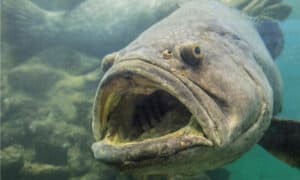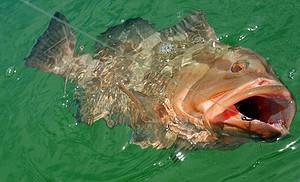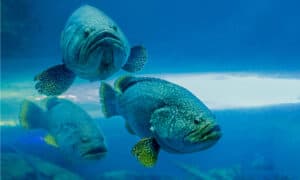In the vast coastal waters of North Carolina, there is a collection of marine life as diverse and vibrant as the state itself. A standout among this aquatic community is the mighty grouper, a fish species celebrated for its size, variety, and significant ecological role.
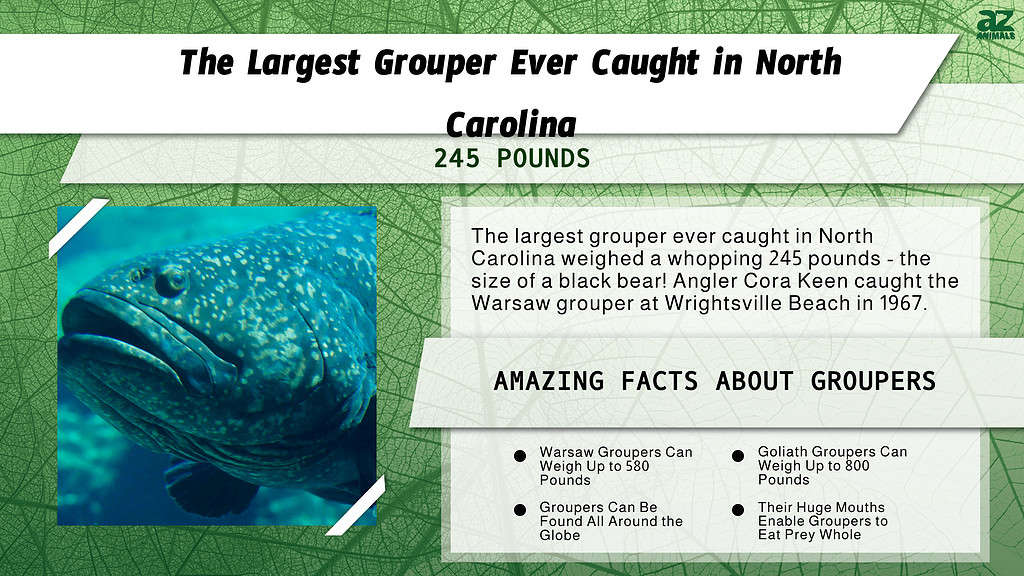
Groupers in North Carolina represent a colorful spectrum of species, each contributing uniquely to the marine ecosystem. From the colossal Warsaw and Goliath groupers to the commonly found red and black groupers, these fish are a testament to the diversity of life beneath the ocean’s surface.
In this article, we discover the largest grouper ever caught in North Carolina. As we dive deeper into understanding groupers, we’ll explore what makes these fish unique, their various species present in North Carolina waters, their essential role in maintaining the health of the marine ecosystem, and their diet and predators.
So, let’s dive in and uncover the fascinating world of North Carolina’s groupers.
The Largest Grouper Ever Caught in North Carolina

Groupers are fish with stout bodies and huge mouths that let them suck in their prey at a distance and gulp the food down whole.
©iStock.com/FtLaudGirl
The largest grouper ever caught in North Carolina weighed an astounding 245 lbs – the size of a black bear. Adult male black bears typically weigh 126–551 lbs., whereas females, being 33% lighter, weigh 90–375 lbs. Angler Cora Keen caught the Warsaw grouper at Wrightsville Beach in 1967.
The Largest Grouper Ever Caught Worldwide
A team of anglers led by Lynn Joyner caught the largest grouper on record on Florida’s Southern Coast in May 1961. This 680-pound fish, which was about seven feet long, took over an hour to reel in.
More recently, in June 2021, a group of anglers caught a 500-pound grouper, but the 1961 record still stands unbeaten.
This record, theoretically, might be surpassable. Documentation exists of Goliath groupers weighing around 800 pounds. Catching one of these giants would undeniably shatter the existing record.
Yet, considering the immense size and strength of these fish, demonstrated by the struggle with the record-breaking grouper, catching such behemoths would present a significant challenge.
The Goliath grouper outstrips all other grouper species in size. For many, hooking one of these could be the catch of a lifetime. The Goliath grouper typically outgrows its peers in certain habitats, like reef locations and shallow waters.
II. What is a Grouper?
Imagine a hefty, robust fish with a sizable mouth. Are you picturing it? That’s a grouper! Groupers are fascinating aquatic creatures that inhabit tropical and subtropical waters across our planet. Now, let’s delve deeper into their world and uncover their intriguing aspects.
Grouper Fundamentals: Diving into the Basics
Hailing from the Serranidae family, specifically the Epinephelinae subfamily, groupers are recognized by their potent jaws and wide, rounded tails. Their bodies boast an assortment of colors and patterns, making each encounter an exciting visual experience.
Size Spectrum: Exploring the Grouper Dimensions

Giant Sea Bass, also known as the goliath grouper, in an aquarium.
©eril Victory/Shutterstock.com
Groupers present a vast size range, from the relatively modestly-sized sea bass to the colossal Goliath grouper, which can extend up to 8.2 feet and weigh a staggering 800 pounds. That’s not the only giant in the family, though; the Warsaw grouper is another heavyweight contender, capable of growing up to 7.5 feet and tipping the scales at over 580 pounds!
The Family of Groupers: A Diversity Parade
There’s more to the term “grouper” than meets the eye. It’s an umbrella term for an estimated 159 different species, including well-known varieties like the Nassau grouper, the red grouper, the black grouper, the Warsaw grouper, and, of course, the Goliath grouper. Each species has its own unique traits and preferred habitats, underlining the grouper family’s impressive diversity.
Unique Characteristics: Standout Features
Groupers are distinctive, not just for their size but also for their unique characteristics. For instance, their swimming style involves the use of their pectoral fins instead of their tail fins. Additionally, groupers have perfected the art of ambush predation, using their vast mouths to engulf prey and swallow it whole – a truly captivating sight!
Global Habitat: Groupers’ Homes Around the World
Groupers aren’t picky about their location; they have a global distribution. They’ve made homes in the Atlantic, Pacific, and Indian Oceans, inhabiting coral reefs, rock formations, and even deeper offshore areas.
The Grouper Species in North Carolina
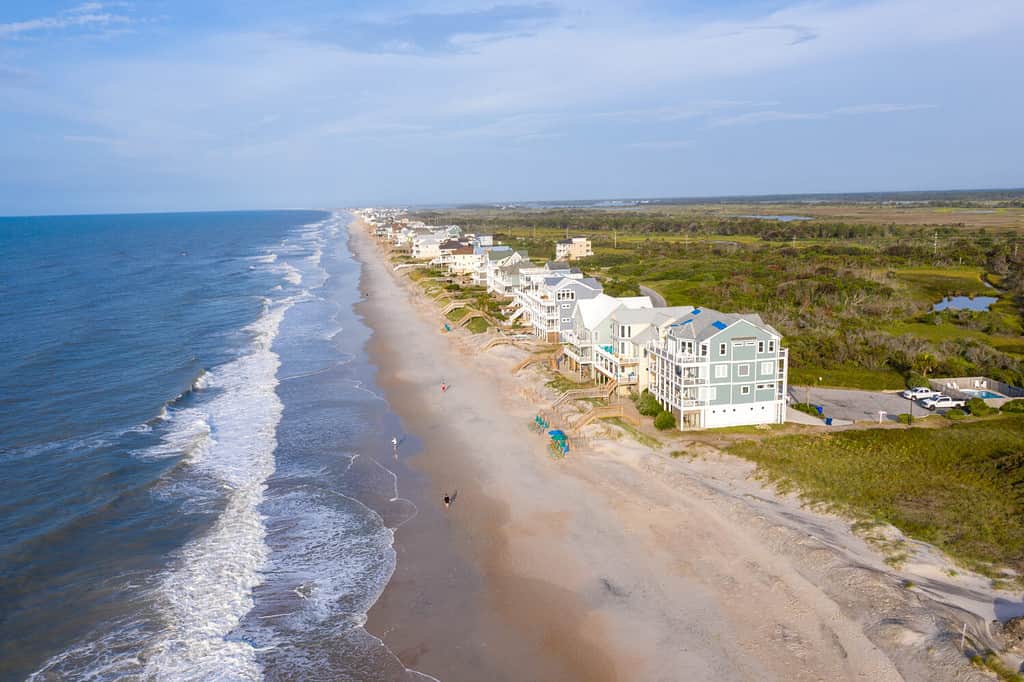
Teeming with beaches, North Carolina is home to a wide variety of marine life.
©MICHAEL HUBEL/Shutterstock.com
North Carolina, a state renowned for its diverse marine life, is home to a range of grouper species. Divers and anglers alike frequent these waters to catch a glimpse of, or even catch, these fascinating fish. Let’s explore the grouper species that grace the coastal waters of North Carolina.
The Grouper Spectrum: Variety in the Waters
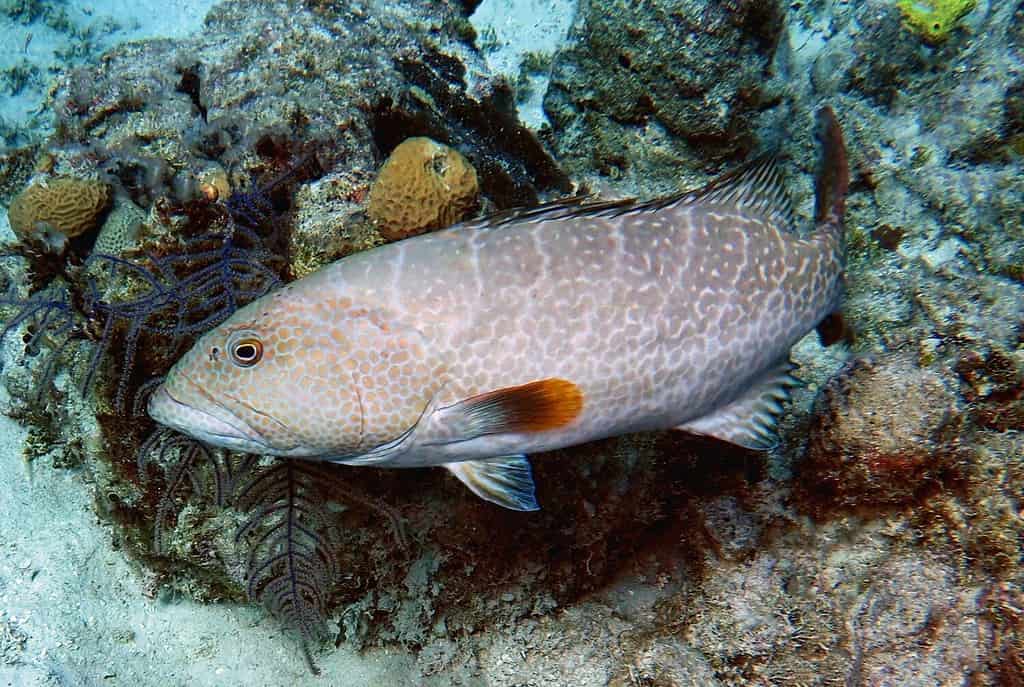
The yellowfin grouper is distinguishable by its yellow fins.
©Daryl Duda/Shutterstock.com
The waters of North Carolina are teeming with a diverse mix of grouper species. This includes the Gag grouper, characterized by its mottled gray or brown body, and the Scamp grouper, recognizable by its elongated dorsal spines. You’ll also find the snowy grouper, a deep-water dweller known for its dark brown or black coloration, and the yellowfin grouper, a striking species with yellowish fins and a greenish body.
The Giant Warsaw Grouper: A Notable Presence
One cannot discuss the grouper species in North Carolina without highlighting the Warsaw grouper. This mammoth fish, which can grow up to 7.5 feet and weigh over 580 pounds, is a remarkable sight in the waters off North Carolina’s coast. This deep-sea dweller, with its distinctive dark color and elongated dorsal spine, is a favorite among anglers and divers due to its size and power.
The Red Grouper: A Common Sight
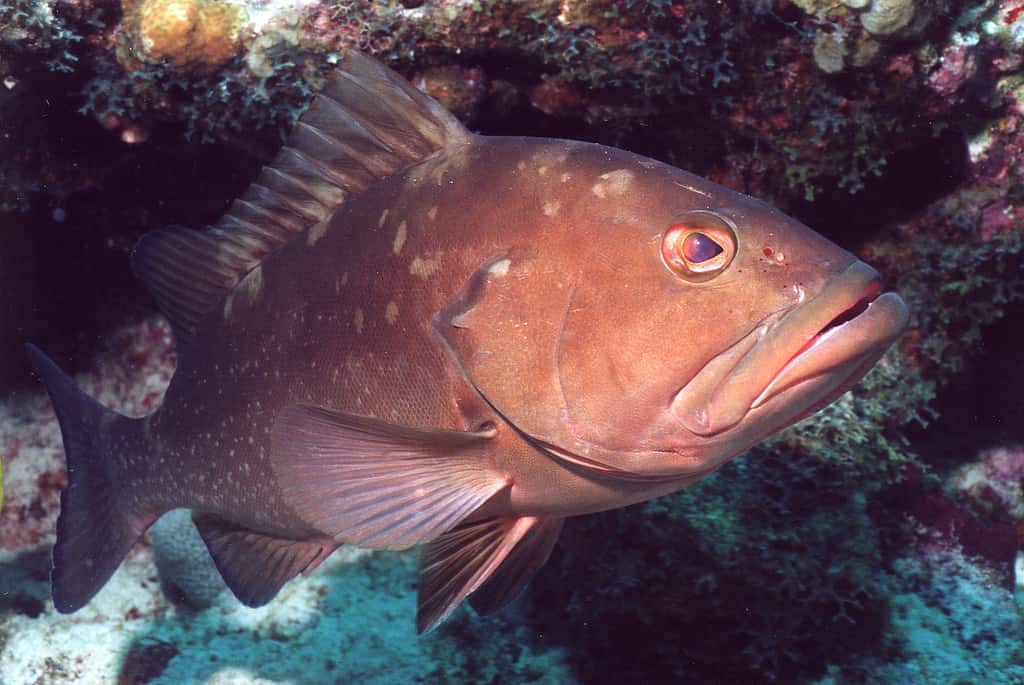
Red Grouper is extremely common in North Carolina.
©iStock.com/dombrowski
The red grouper is another species that is often found in North Carolina’s waters. Characterized by its reddish-brown hue and a body covered in scattered white spots, the red grouper is a popular target for commercial and recreational fishers due to its size and culinary value.
Where to Find Groupers in North Carolina
Groupers inhabit a variety of habitats off the North Carolina coast, from shallow reefs and rocky outcroppings to deeper offshore environments. The specific habitat often depends on the species; for instance, Warsaw groupers are more commonly found in deep-sea environments, while gag groupers can often be found in shallower waters near reefs.
Diet of Groupers
Groupers are known for their robust physiques and equally voracious appetites. Their feeding habits not only dictate their survival but also play a vital role in maintaining marine biodiversity and ecological balance.
Gourmet of the Deep: What Groupers Eat
At mealtime, groupers opt for an array of aquatic creatures. As carnivores, they consume smaller fish, crustaceans such as crabs and shrimps, octopuses, and, occasionally, juvenile sea turtles. Their wide mouths and powerful jaws make for efficient hunting and feeding tools, enabling them to engulf their prey swiftly and efficiently.
Dietary Variations Among Different Grouper Species
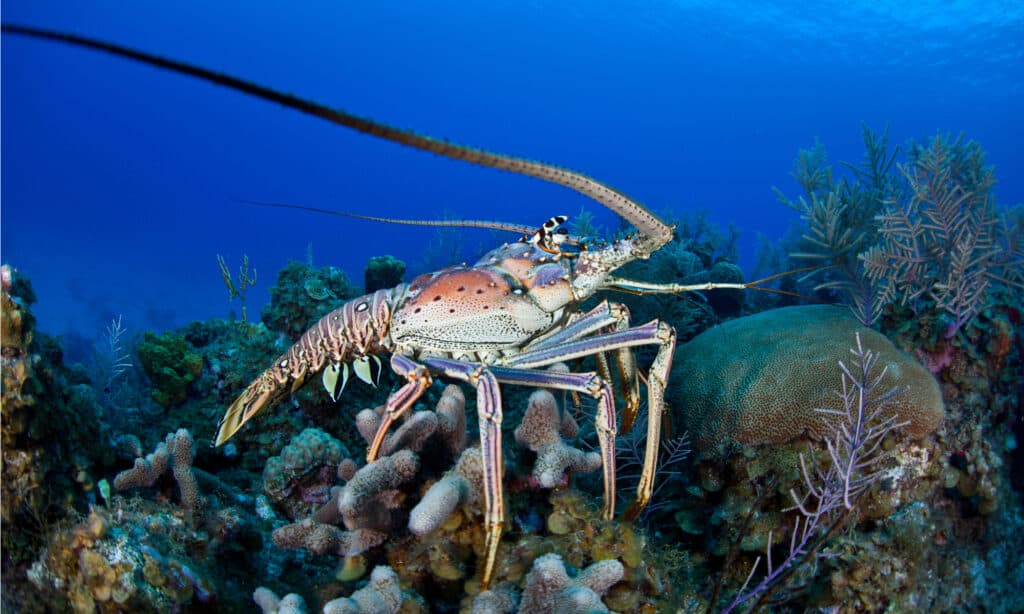
Spiny Lobster is a favorite among Goliath and Warsaw Groupers.
©Ethan Daniels/Shutterstock.com
It’s important to note that not all groupers have the same dietary preferences.
The larger groupers, including the Goliath and Warsaw, naturally require more substantial meals. Due to their size, they tend to prey on larger organisms, including spiny lobsters, large crabs, and sizeable fish.
Smaller grouper species, like the red grouper, focus their diet more on smaller fish and invertebrates. Despite their smaller size, they are efficient predators, contributing significantly to the population control of their prey species.
Predators of Groupers
Even the mighty grouper, despite its size and strength, faces predation in the marine world. Understanding the threats to groupers not only sheds light on the circle of life in the oceans but also emphasizes the importance of conservation efforts for these magnificent fish.
Who Preys on the Predator?
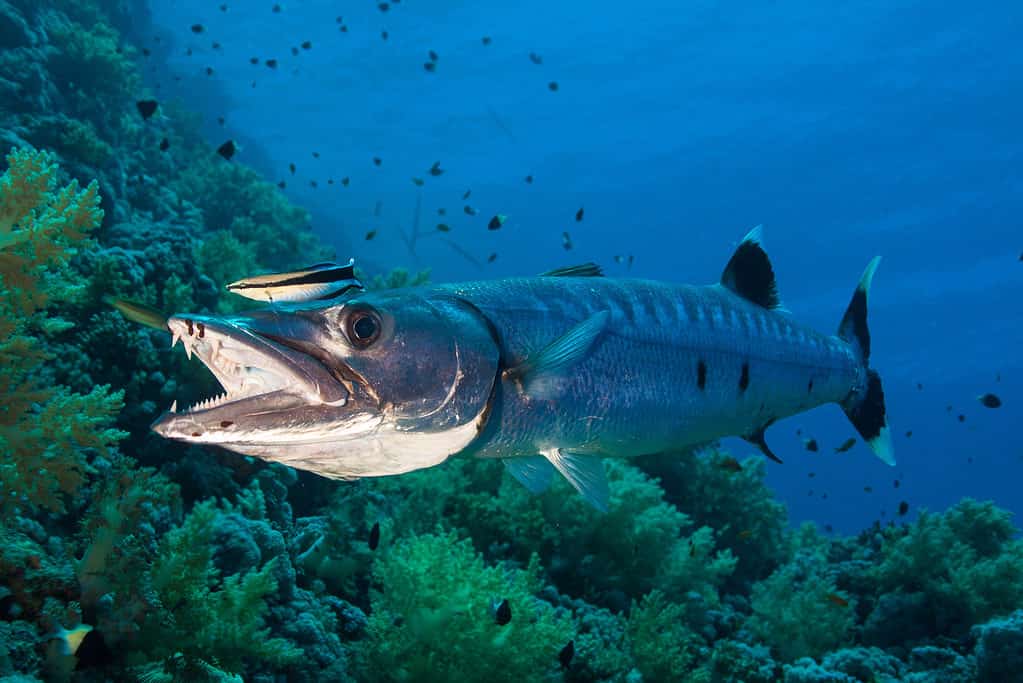
Large barracuda will target grouper as prey.
©Itstvan Kovacs/Shutterstock.com
While groupers are formidable predators, they, too, become prey for a variety of larger marine animals. Sharks, particularly the bull shark and tiger shark, are known to prey on groupers. Additionally, larger fish such as moray eels and barracudas target groupers. Even the enormous Goliath grouper falls victim to larger sharks.
The Size Factor: Larger Groupers Face Larger Predators
The size of a grouper often determines the nature of its predators. Larger groupers, like the Warsaw and Goliath, face threats primarily from big sharks. Smaller grouper species, on the other hand, need to be wary of a wider variety of predators, including larger fish of their own species, moray eels, and even larger crustaceans.
Predation Pressure and Grouper Populations
Predation plays a critical role in controlling grouper populations in North Carolina. It is a natural mechanism that helps maintain the balance of marine life. However, over-predation or a significant increase in predator numbers can pose threats to grouper populations, potentially leading to a decrease in their numbers.
Defense Mechanisms: How Groupers Fight Back
Groupers are not defenseless victims. They have a few tricks up their fins to evade predators. Their coloration often allows them to blend with their surroundings, providing excellent camouflage. In addition, their strong, muscular bodies enable swift escape movements when a threat is detected.
The Ecological Role of Grouper in North Carolina
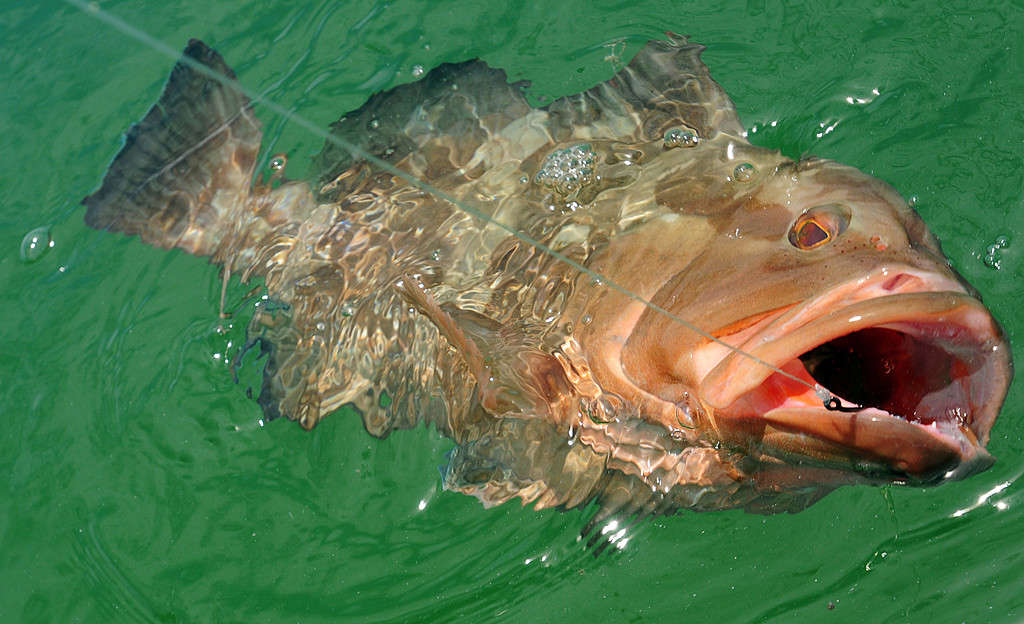
Red grouper plays a crucial part in controlling the populations of their prey species.
©iStock.com/FtLaudGirl
Groupers play a pivotal role in maintaining the ecological balance in the waters off North Carolina’s coast. As both predators and prey, they’re integral to the underwater food chain. Let’s delve deeper into the ecological significance of these mighty fish in the coastal ecosystems of North Carolina.
Groupers as Predators: Balancing the Food Chain
As ambush predators, groupers, including the Warsaw grouper and red grouper, play a crucial part in controlling the populations of their prey species, which often include crustaceans and smaller fish. This predatory behavior keeps the food chain in check and contributes to the overall health of the marine ecosystem.
Groupers as Prey: Sustaining Larger Predators
Despite their size and strength, groupers also serve as prey for larger marine predators such as sharks. By providing a food source for these top-level predators, groupers help to ensure their survival and maintain the balance of marine life.
Role in Reef Ecosystems: Guardians of the Coral Reefs
Groupers, particularly species that dwell in shallow waters and coral reefs, play a vital role in preserving reef health. By feeding on a variety of organisms, they help control populations that could otherwise harm the reef, such as certain types of starfish and sea urchins.
Impact on Local Fisheries: An Economic Booster
Groupers are not just ecologically important; they are also economically significant. The grouper fishing industry, both commercial and recreational, contributes considerably to North Carolina’s economy. Groupers are highly sought-after for their size, fighting spirit, and culinary value, making them key species in the local fisheries industry.
Key Takeaways
Exploring the world of groupers, especially those that inhabit the waters off North Carolina’s coast, uncovers a tale of strength, survival, and ecological significance. These remarkable fish, with their impressive size, unique traits, and varied species, certainly leave a lasting impression.
From their significant role in the marine ecosystem, as both predator and prey, to their remarkable diet that maintains the balance of the underwater world, groupers play a key part in shaping the oceanic environment. They also add significant value to the local fishing industry, contributing to North Carolina’s economy and cultural heritage.
But it’s not just about what groupers do or how they impact their surroundings. It’s also about their inherent beauty and majesty, from the colossal Warsaw grouper to the vibrant red grouper. Each grouper species adds a unique touch to the underwater canvas, making our marine world a richer, more fascinating place.
The photo featured at the top of this post is © isidoros andronos/Shutterstock.com
Thank you for reading! Have some feedback for us? Contact the AZ Animals editorial team.




